Gupta Empire › Aztec Food & Agriculture » Origins and History
Articles and Definitions › Contents
- Gupta Empire › Ancient History
- Aztec Food & Agriculture › Antique Origins
Ancient civilizations › Historical places, and their characters
Gupta Empire › Ancient History
Definition and Origins
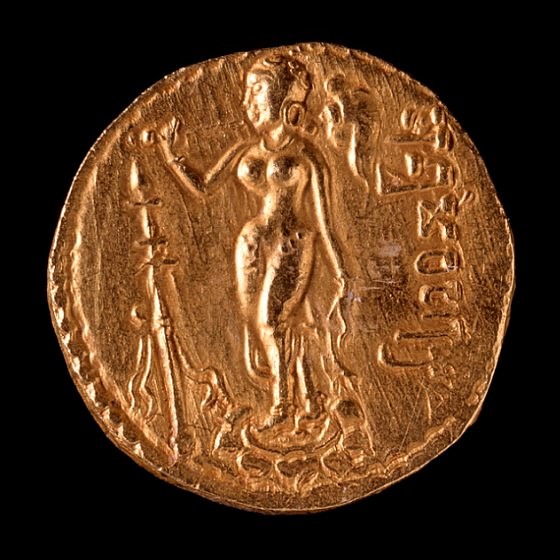
The Gupta Empire stretched across northern, central and parts of southern India between c. 320 and 550 CE. The period is noted for its achievements in the arts, architecture, sciences, religion, and philosophy. Chandragupta I (320 – 335 CE) started a rapid expansion of the Gupta Empire and soon established himself as the first sovereign ruler of the empire. It marked the end of 500 hundred years of domination of the provincial powers and resulting disquiet that began with the fall of the Mauryas. Even more importantly, it began a period of overall prosperity and growth that continued for the next two and half centuries which came to be known as a “Golden Age” in India's history. But the seed of the empire was sown at least two generations earlier than this when Srigupta, then only a regional monarch, set off the glory days of this mighty dynasty in circa 240 CE.
GUPTA PERIOD – EARLY DAYS TO THE ZENITH
Not much is known about the early days of this Gupta dynasty. The travel diaries and writings of Buddhist monks who frequented this part of the world are the most trustworthy sources of information we have about those days. The travelogues of Fa Hien (Faxian, circa 337 – 422 CE), Hiuen Tsang (Xuanzang, 602 – 664 CE) and Yijing (I Tsing, 635 – 713 CE) prove to be invaluable in this respect. The Gupta Empire during the rule of Srigupta (circa 240 – 280 CE) comprised only Magadha and probably a part of Bengal too. Like the Mauryas and other Magadha kings who preceded him, Srigupta ruled from Pataliputra, close to modern day Patna. Srigupta was succeeded to the throne by his son Ghatotkacha (circa 280 – 319 CE).
THE TERRITORIAL HEADS RULING OVER VARIOUS PARTS OF INDIA COULD NOT COUNTER THE SUPERIOR ARMED FORCES OF CHANDRAGUPTA I AND HAD TO SURRENDER BEFORE HIM.
CHANDRAGUPTA I
From the Kushans, the Gupta kings learned the benefit of maintaining a cavalry and Chandragupta I, son of Ghatotkacha, made effective use of his strong army. Through his marriage with Licchhavi Princess Kumaradevi, Chandragupta I received the ownership of rich mines full of iron ore adjacent to his kingdom. Metallurgy was already at an advanced stage and forged iron was not only used to meet the internal demands, but also became a valuable trade commodity. The territorial heads ruling over various parts of India could not counter the superior armed forces of Chandragupta I and had to surrender before him. It is conjectured that at the end of his reign, the boundary of the Gupta Empire already extended to Allahabad.
SAMUDRAGUPTA
Samudragupta (circa 335 – 375 CE), Chandragupta I's son who ascended the throne next, was a military genius and he continued the growth of the kingdom. After conquering the remainder of North India, Samudragupta turned his eyes to South India and added a portion of it to his empire by the end of his Southern Campaign. It is generally believed that during his time the Gupta Empire spanned from the Himalayas in north to the mouth of Krishna and Godavari rivers in the South, from Balkh, Afghanistan in the west to the Brahmaputra River in the east.
Samudragupta was very attentive to rajdharma (duties of a king) and took special care to follow Kautilya ’s (350 – 275 BCE) Arthashastra (an economic, social and political treatise that has clear instructions about how a monarchy should be governed) closely. He donated large sums of money for various philanthropic purposes, including the promotion of education.Besides being a courageous king and able administrator, he was a poet and musician. The large number of gold coins circulated by him showcases his multifaceted talent. An inscription, probably commissioned by subsequent Gupta kings, known as the Allahabad Pillar is most eloquent about his humane qualities. Samudragupta also believed in promoting goodwill among various religious communities. He gave, for example, Meghavarna, king of Ceylon, permission and support for the construction of a monastery in Bodh Gaya.
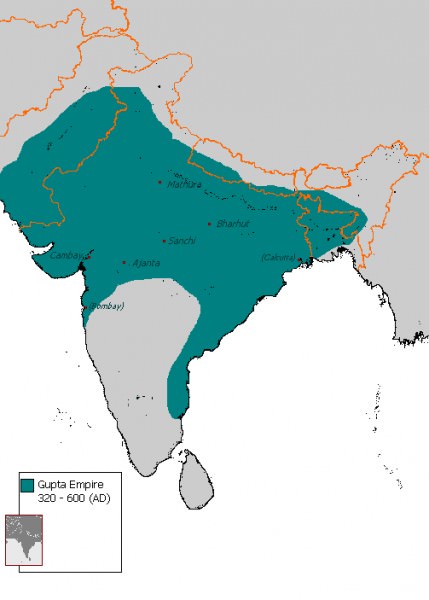
Gupta Empire
CHANDRAGUPTA II
A short struggle for power appears to have ensued after the reign of Samudragupta. His eldest son Ramagupta became the next Gupta king. This was noted by 7th century CE Sanskrit author Banbhatta in his biographical work, Harshacharita. What followed next forms a part of Sanskrit poet and playwright Visakh Dutta's drama Devi Chandra Guptam. As the story goes, Ramagupta was soon overcome by a Scythian king of Mathura. But the Scythian king, besides the kingdom itself, was interested in Queen Dhruvadevi who was also a renowned scholar. To maintain peace Ramagupta gave up Dhruvadevi to his opponent. It is then Ramagupta's younger brother Chandragupta II with a few of his close aides went to meet the enemy in disguise. He rescued Dhruvadevi and assassinated the Scythian king. Dhruvadevi publicly condemned her husband for his behaviour. Eventually, Ramagupta was killed by Chandragupta II who also married Dhruvadevi sometime later.
Like Samudragupta, Chandragupta II (circa 380 – 414 CE) was a benevolent king, able leader and skilled administrator. By defeating the satrap of Saurashtra, he further expanded his kingdom to the coastline of the Arabian Sea. His courageous pursuits earned him the title of Vikramaditya. To rule the vast empire more efficiently, Chandragupta II founded his second capital in Ujjain. He also took care to strengthen the navy. The seaports of Tamralipta and Sopara consequently became busy hubs of maritime trade. He was a great patron of art and culture too. Some of the greatest scholars of the day including the navaratna (nine gems) graced his court. Numerous charitable institutions, orphanages and hospitals benefitted from his generosity. Rest houses for travellers were set up by the road side. The Gupta Empire reached its pinnacle during this time and unprecedented progress marked all areas of life.
POLITICS & ADMINISTRATION
Great tact and foresight were shown in the governance of the vast empire. The efficiency of their martial system was well known. The large kingdom was divided into smaller pradesha (provinces) and administrative heads were appointed to take care of them. The kings maintained discipline and transparency in the bureaucratic process. Criminal law was mild, capital punishment was unheard of and judicial torture was not practised. Fa Hien called the cities of Mathura and Pataliputra as picturesque with the latter being described as a city of flowers. People could move around freely. Law and order reigned and, according to Fa Hien, incidents of theft and burglary were rare.
The following also speaks volumes about the prudence of the Gupta kings. Samudragupta acquired a far greater part of southern India than he cared to incorporate into his empire. Therefore, in quite a few cases, he returned the kingdom to the original kings and was satisfied only with collecting taxes from them. He reckoned that the great distance between that part of the country and his capital Pataliputra would hinder the process of good governance.
SOCIO-ECONOMIC CONDITIONS
People led a simple life. Commodities were affordable and all round prosperity ensured that their requirements were met easily. They preferred vegetarianism and shunned alcoholic beverages. Gold and silver coins were issued in great numbers which is a general indicative of the health of the economy. Trade and commerce flourished both within the country and outside.Silk, cotton, spices, medicine, priceless gemstones, pearl, precious metal and steel were exported by sea. Highly evolved steelcraft led everyone to a belief that Indian iron was not subject to corrosion. The 7 m (23 ft) high Iron Pillar in Qutub complex, Delhi, built around 402 CE, is a testimony to this fact. Trade relations with Middle East improved. Ivory, tortoise shell etc. from Africa, silk and some medicinal plants from China and the Far East were high on the list of imports. Food, grain, spices, salt, gems and gold bullion were primary commodities of inland trade.
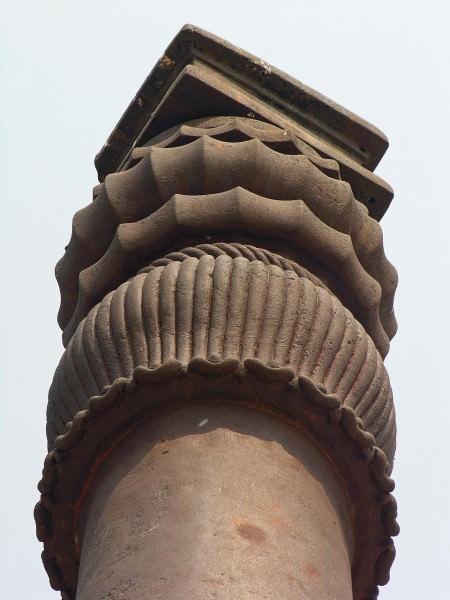
Iron Pillar of Delhi
RELIGION
Gupta kings knew that the well-being of the empire lie in maintaining a cordial relationship between the various communities.They were devout Vaishnava (Hindus who worship the Supreme Creator as Vishnu ) themselves, yet that did not prevent them from being tolerant towards the believers of Buddhism and Jainism. Buddhist monasteries received liberal donations.Yijing observed how the Gupta kings erected inns and rest houses for Buddhist monks and other pilgrims. As a pre-eminent site of education and cultural exchange Nalanda prospered under their patronage. Jainism flourished in northern Bengal, Gorakhpur, Udayagiri and Gujarat. Several Jain establishments existed across the empire and Jain councils were a regular occurrence.
LITERATURE, SCIENCES & EDUCATION
Sanskrit once again attained the status of a lingua franca and managed to scale even greater heights than before. Poet and playwright Kalidasa created such epics as Abhijnanasakuntalam, Malavikagnimitram, Raghuvansha and Kumarsambhaba.Harishena, a renowned poet, panegyrist and flutist, composed Allahabad Prasasti, Sudraka wrote Mricchakatika, Vishakhadatta created Mudrarakshasa and Vishnusharma penned Panchatantra. Vararuchi, Baudhayana, Ishwar Krishna and Bhartrihari contributed to both Sanskrit and Prakrit linguistics, philosophy and science.
Varahamihira wrote Brihatsamhita and also contributed to the fields of astronomy and astrology. Genius mathematician and astronomer Aryabhata wrote Surya Siddhanta which covered several aspects of geometry, trigonometry and cosmology.Shanku devoted himself to creating texts about Geography. Dhanvantri's discoveries helped the Indian medicinal system of ayurveda become more refined and efficient. Doctors were skilled in surgical practices and inoculation against contagious diseases was performed. Even today, Dhanvantri's birth anniversary is celebrated on Dhanteras, two days before Diwali. This intellectual surge was not confined to the courts or among the royalty. People were encouraged to learn the nuances of Sanskrit literature, oratory, intellectual debate, music and painting. Several educational institutions were set up and the existing ones received continuous support.
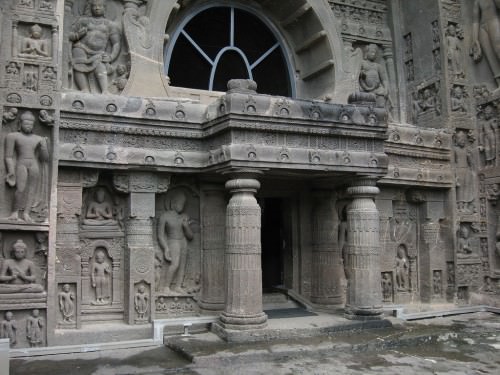
Cave 19, Ajanta, Deccan
ART, ARCHITECTURE & CULTURE
What philosopher and historian Ananda Coomaraswamy said in The Arts & Crafts of India & Ceylone, about the art of the region must be remembered here,
The Hindus do not regard the religious, aesthetic, and scientific standpoints as necessarily conflicting, and in all their finest work, whether musical, literary, or plastic, these points of view, nowadays so sharply distinguished, are inseparably united.
The finest examples of painting, sculpture and architecture of the period can be found in Ajanta, Ellora, Sarnath, Mathura, Anuradhapura and Sigiriya. The basic tenets of Shilpa Shasrta (Treatise on Art) were followed everywhere including in town planning. Stone studded golden stairways, iron pillars (The iron pillar of Dhar is twice the size of Delhi's Iron Pillar), intricately designed gold coins, jewellery and metal sculptures speak volumes about the skills of the metalsmiths. Carved ivories, wood and lac-work, brocades and embroidered textile also thrived. Practicing vocal music, dance and seven types of musical instruments including veena (an Indian musical stringed instrument), flute and mridangam (drum) were a norm rather than exception. These were regularly performed in temples as a token of devotion. In classic Indian style, artists and litterateurs were encouraged to meditate on the imagery within and capture its essence in their creations. As Agni Purana suggests, “O thou Lord of all gods, teach me in dreams how to carry out all the work I have in my mind.”
DECLINE OF THE EMPIRE
After the demise of his father Chandragupta II, Kumaragupta I (circa 415 – 455 CE) ruled over the vast empire with skill and ability. He was able to maintain peace and even fend off strong challenges from a tribe known as Pushyamitra. He was helped by his able son Skandagupta (455 – 467 CE) who was the last of the sovereign rulers of the Gupta Dynasty. He also succeeded in preventing the invasion of the Huns (Hephthalites). Skandagupta was a great scholar and wise ruler. For the well being of the denizens he carried out several construction works including the rebuilding of a dam on Sudarshan Lake, Gujarat. But these were the last of the glory days of the empire.
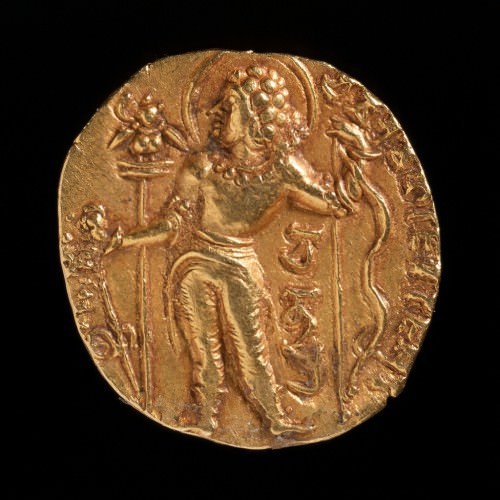
Gold Coin - Gupta Period
After Skandagupta's death the dynasty became embroiled with domestic conflicts. The rulers lacked the capabilities of the earlier emperors to rule over such a large kingdom. This resulted in a decline in law and order. They were continuously plagued by the attacks of the Huns and other foreign powers. This put a dent in the economic well-being of the empire. On top of this, the kings remained more occupied with self-indulgence than in preparing to meet with the challenges of their enemies.The inept ministers and administrative heads also followed suit. Notably, after the defeat and capture of Mihirakula, one of the most important Hephthalite emperors of the time, Gupta King Baladitya set him free on the advice of his ministers. The Huns came back to haunt the empire later and finally drew the curtains on this illustrious empire in circa 550. The following lines of King Sudraka's Mricchakatika (The Little Clay Cart) aptly sum up the rise and fall in the fortune of the Gupta Dynasty.
Fate plays with us like buckets at the well,
Where one is filled, and one an empty shell,
Where one is rising, while another falls;
And shows how life is change - now heaven, now hell.
Where one is filled, and one an empty shell,
Where one is rising, while another falls;
And shows how life is change - now heaven, now hell.
Aztec Food & Agriculture › Antique Origins
Ancient Civilizations
The Aztec civilization, which flourished in central Mexico between c. 1345 and 1521 CE, was able to provide, through a combination of climatic advantages, diverse artificial irrigation methods, and extensive farming know-how, an astonishingly wide range of agricultural produce that gave them one of the most varied cuisines in the ancient world.
ORGANIZATION & METHODS
In Aztec society, land could be owned by communities ( calpolli ) and parceled out to individual families for cultivation, or farmers could be resident tenants ( mayeque ) on large, privately owned estates. Rent was paid in kind to the landowners who were either Aztec nobles ( pipiltin ), warriors given the land as a reward for services rendered, or the king himself ( tlatoani ), who all managed their estates through intermediary administrators. On a smaller scale, it was also typical for commoners ( macehualtin ) to have their own garden plot ( calmil ), which could supply the family with food. At the bottom of the social strata were slaves ( tlacohtin ) who, besides working in other industries, were also widely engaged in agriculture.
Two groups of agricultural workers may be distinguished - the general farm labourers who tended the fields, planted, and irrigated crops, and the more specialised horticulturalists who had knowledge of seeding, transplanting, crop rotation, and the best times to plant and harvest. The latter information could be determined from the tonalamatl almanacs, and they not only considered climatic conditions but also auspicious periods and events after which planting and harvesting should take place.

Aztec Agriculture
To maximise crop yields, various measures were taken. For example, terracing to increase the area of farmland was widely used, especially from the reign of Netzahualcoyotl. Irrigation was also employed across the Aztec Empire, sometimes in ambitious large-scale projects, such as the diversion of the Cuauhtitlan River to water surrounding fields, but more commonly via artificially flooded fields known as chinampas (see below). Crops were also fertilized using a combination of sludge dredged from the canals constructed wherever Aztecs took up residence and with human excrement, purposely collected from the urban centres.
Still, despite these measures, crop yields could be significantly reduced by unfavourable natural events such as excessive rain and even snow or plagues of such pests as locusts and rodents. Accordingly, reserves of grain were accumulated to be redistributed to the destitute in such hard times.
THE MOST FAMOUS & LARGEST MARKET WAS AT TLATELOLCO, WHICH EACH DAY ATTRACTED 25,000 SHOPPERS.
All manner of foodstuffs were cultivated, and non-food crops included cotton and tobacco, which was smoked either in a pipe or rolled into cigars. Once harvested, goods were sold in markets held in the central plaza of all towns. The most famous and largest was the market at Tlatelolco, which each day attracted 25,000 shoppers and as many as 50,000 at the special market held on every fifth day.
CHINAMPAS
Chinampas were artificially raised and flooded fields used for cultivation, and they covered large areas of the Chalco-Xochimilco basin and greatly increased the agricultural capacity of the land. In fact, as many as six crops a year could be grown on the chinampas; no wonder then, that they continue to be used in the present day. Their use in Mesoamerica went back centuries, but it was not until the 13th and 14th centuries CE that they began to spread beyond the lake basin of Chalco-Xochimilco where they eventually covered up to 9,500 hectares (23,000 acres). The chinampas could feed an ever-growing population, which at the capital Tenochtitlan alone was at least 200,000 and perhaps 11,000,000 throughout the empire.Motecuhzoma I, in particular, embarked on an expansion project in the 15th century CE, probably as a direct response to the needs of a rapidly growing population.
Each chinampa field was remarkably similar in size and orientation. Measuring around 30 x 2.5 m, they were pegged out in marshy areas using long stakes. Each plot was bordered with a fence made of intertwined branches which, over time, became more solid as they collected mud and vegetation. The wall was further strengthened by the planting of willow trees at regular intervals. The planting area within the chinampa was filled with sediment and between each plot was a canal which gave access for canoes. The water was provided, and carefully controlled, by a combination of natural springs and artificial constructions such as aqueducts, dikes, dams, canals, reservoirs, and gates. One of the most impressive of these was the 16 km dyke built by Nezahualcoyotl on the edge of Tenochtitlan to block the salty water of Lake Texcoco and create a lagoon supplied by a fresh water spring.
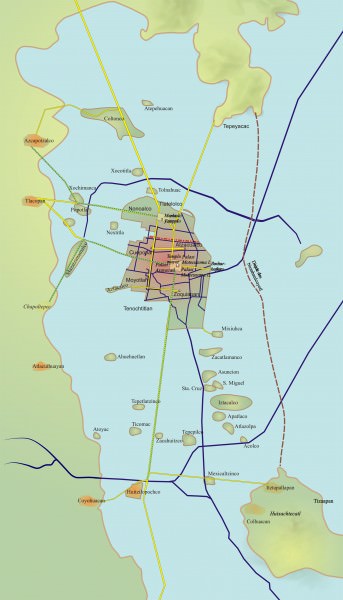
Tenochtitlan
GARDENS
The Aztecs also appreciated the cultivation of flower gardens and these were dotted around Tenochtitlan. The most famous example is Motecuhzoma I's exotic botanical garden at Huaxtepec, for which he imported such flowers as the vanilla orchid and cacao trees from the coast, along with specialist gardeners to ensure that they thrived in their new environment. The gardens were irrigated via springs, streams, and artificial canals and featured fountains and artificial lakes. The gardens at Huaxtepec and others such as the ones created by Netzahualcoyotl at Tetzcotzingo were also used to grow foodstuffs and were noted for having plants and trees of medicinal value. In fact, most Aztec upper-class residences had their own pleasure gardens with water features, orchards and herb gardens.
FOOD & DRINK
The Aztec diet was dominated by fruit and vegetables, as domesticated animals were limited to dogs, turkeys ( totolin ), ducks, and honey bees. Game (especially rabbits, deer and wild pigs), fish, birds, salamanders, algae (used to make cakes), frogs, tadpoles and insects were also a valuable food source. The most common crops were maize ( centli, famously used to make tortillas but also tamales and gruel), amaranth (a grain), sage, beans ( etl ), squash, and chile peppers. Red and green tomatoes were cultivated (but were much smaller than the modern variety), as were white sweet potatoes, jícama (a type of turnip), chayote (vegetable pear), the nopal cactus, and peanuts. The Aztecs also grew many types of fruit including guavas, papayas, custard apples, mamey, zapotes, and chirimoyas. Snacks included popcorn and the sweet baked leaves of the maguey agave.
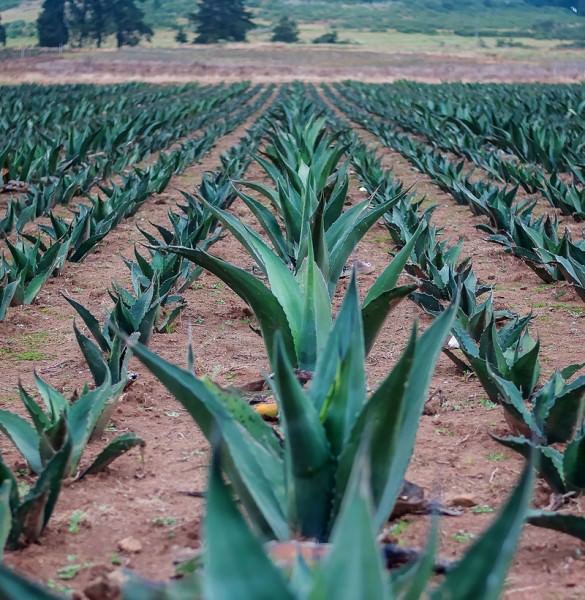
Maguey
Not using oils or fats, most dishes were either boiled or grilled, and extra taste was added using condiments, for the Aztecs loved their sauces and seasoning. Examples of these include epazote, toasted avocado leaves, achiote seeds, and, of course, chile peppers either fresh, dried, or smoked. The other two popular flavours for the Aztecs were vanilla and chocolate. The latter came from the beans of cacao pods from the tree which was widely cultivated in extensive orchards near the coast.Beans were fermented, cured, and roasted. Then the beans were ground into powder and mixed with hot water as chocolate was usually consumed as a warm frothy drink. Bitter to taste, it could be flavoured by adding, for example, maize, vanilla, flowers, herbs and honey. So esteemed was chocolate that beans were used as money (even counterfeited) and demanded as tribute from subject tribes. Other popular drinks were octli ( pulque to the Spanish), a light alcoholic beer made from the fermented sap of the maguey and pozolli made from fermented maize dough. These alcoholic drinks were, however, consumed in moderation, as being caught drunk could result in all manner of punishments, even the death penalty.
LICENSE:
Article based on information obtained from these sources:with permission from the Website Ancient History Encyclopedia
Content is available under License Creative Commons: Attribution-NonCommercial-ShareAlike 3.0 Unported. CC-BY-NC-SA License